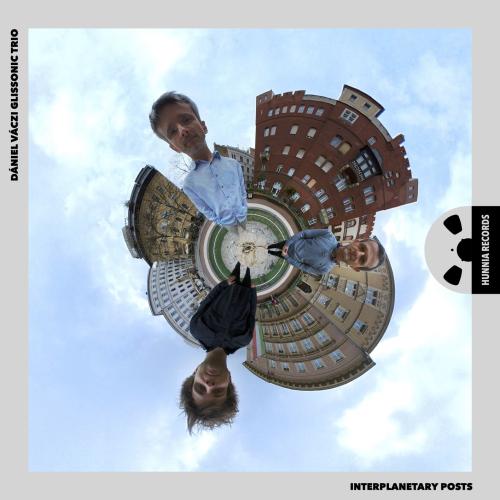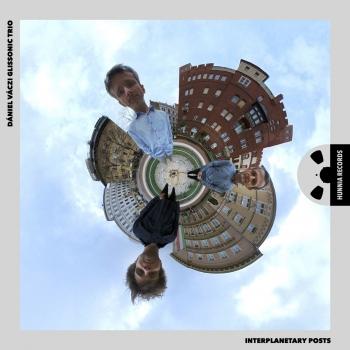
Interplanetary Posts Dániel Váczi Glissonic Trio
Album info
Album-Release:
2024
HRA-Release:
12.03.2024
Album including Album cover Booklet (PDF)
- 1 Post 1 03:55
- 2 Post 2 06:40
- 3 Post 3 05:55
- 4 Post 4 04:01
- 5 Post 5 02:09
- 6 Post 6 04:08
- 7 Post 7 07:14
- 8 Post 8 05:33
Info for Interplanetary Posts
This trio that is creating spontaneous textures from outer and inner space should enthrall and capture the attention of listeners familiar with the musical experiments of the last century and the inventiveness of the first quarter of the twenty-first century.
What is obvious is the fluidity of the interchange between players with a jazz-improving background but who have chosen another sonic path. So how do we prepare ourselves for the unexpected? With open mind and open ears set sail on a sonic trip.
What are some helpful keywords for this collection of improvisations?
Questions, timbral transformations, independent lines, temporal contours, distant, even fuzzy memories; long-lost jazz and modern classical manners. Time travel towards the interplanetary.
Interplanetary Post album starts with a clever meandering of the hybrid instrument, the Glissotar. Short glissandi flirt with modality and jazz harmonic envelopes from the keyboard. Perhaps Miles stepped to observe his influence, but pointillistic textures bring us back to questions of outer space.
Post 2 emerges from a distant planet; an exquisite example of musical weightlessness. Diluted distance between events that glide at different speeds with simple, sparse percussiveness. Midway the Glissotar in its’ expressive lower register suggests melodic curves, echoed in cloudy electric pianistic harmony. Percussionist digging deeply into the earth’s crust; minimal repetitive phrases conclude this post.
Next discovery: a provocative texture where a folk-like melody covered in the subtle breath work of our cornetting soloist is underlined by deep electronics that introduce isolated piano tones. Our percussionist returns with sea shells from a deserted beach. The Glissotar with pronounced controlled glissandi recalls Ondes Martenot of the French contemporary scene à la Messiaen. The piano becomes atonally expansive as percussive time and timbre insistently change. Where would our modern times be if we forget the Monk or Steve Lacy legacy?
This is the question Post four seems to suggest. Carefully chosen melodic fragments move to glissandi before the silent way of percussion bell-like keyboards underpinned by staccato motifs and medium tremolos warbles that Glissotar friends name « snapping », rhythm section takes off in joyous crystalline tempo, ignoring a hovering Glissotar in tranquil mode; long and large interval melody ends this conversation.
Post 5 in duo format is short, intense spectral-sparked keyboard with ascending harmonic scales, leading to noisy interrupted conversation with a snapping Glissotar.
Oscillations could be the subtitle for Post six; a relentless perfect forth begs for contrast from the rhythm section. Keyboard fourths with added semitone bites push the Glissotar into rapid glissandi, the electric piano steps in, and the percussion listens carefully to his brush attacks. A new section in détaché mode with question and answer phrases. More and more questions, but less and less answers.
A solemn « Asian gong » spirit with restless toms introducing poignant inflections introduces Post 7; then arrives a cluster of cymbals, metallic skin textures invite the piano with bell-like vertical harmonies. The music then welcomes the return of a softer chromatic Glissotar, bringing stability to an otherwise expressive atonal universe, with the spirits of the second Viennese school watching on approvingly to the counterpoint that gradually fades into the far east.
The album concludes with an imaginative and actually joyful Glissotar solo using many of the fascinating trills and tremolos that give at times electronic colors, even underwater gurgling effects to this acoustic hybrid instrument. We hear a constant fluctuation of pitch freed from the chromatic scale that has trained our listening habits lifelong. Dániel Váczi is in a liberated glissando mode racing up and down a musical ski slope.
It is time to return to our earthly routines, but hopefully we have gone through some process of perceptive transportation thanks to our flight crew, the Dániel Váczi Glissotar Trio from Budapest.
Dániel Váczi, glissotar (glissonic tarogato), sopranino saxophone
Máté Pozsár, Steinway Model D Concert Grand Piano, Rhodes, analogue synthesizer
Zsolt Sárvári Kovács, drums
Dániel Váczi Glissonic Trio
Glissonic is a completely new wind instrument family, invented by Dániel Váczi, developing with Tóbiás Terebessy since 2016. The main novelty is that instead of tone holes it uses a longitudinal gap or slot on the tube of the instrument. The two sides of the slot are covered with magnetic foil which attract a magnetized ribbon on top. The ribbon is fixed on the upper end, stretched and lifted up from the lower end as a string on a violin. You can push down the ribbon anywhere, it will seal up perfectly above it, so you can produce any note in the pitch continuum. It can be played with eight fingers of the two hands or by sliding one finger up and down. The glissonic system can be used on all kinds of wind instruments: flute, whistle, clarinet, saxophone, oboe etc. The first model is the glissotar, based on the Hungarian tarogato, which is a single-reed instrument with a conical wooden body.
The program of Daniel Vaczi’s Glissonic Trio revolves around the glissonic instruments that Vaczi has invented. His partners in this are two pillars of the Hungarian free and experimental jazz scene, Máté Pozsár, with whom they also play in the Decolonize Your Mind Society, and Zsolt Sárvári Kovács, with whom Dániel has been playing in various formations for twenty-five years.
Dániel Váczi
is a saxophone player, composer, inventor and researcher of musical instruments and games.
Born in 1972, Budapest.
He founded his jazz trio in 2001. It became a quintet called Multet in 2009. He developed a “Reticular Music System” which is both a music theoretical approach and a technique for composing and improvising on the other. His invented a new woodwind family: the Glissonic.
Daniel Vaczi is one of the most exciting, multi-talented and versatile musicians of the Hungarian music scene. An inventor of instrument-families (Glissonic) and logic games (Urobo), composer, saxophonist and multi-instrumentalist, he explores and pushes the boundaries of classical, contemporary and jazz. He composes music for different formations, player piano/organ etc… As a musical theorist he invented a new musical system called ‘reticular’, meaning grid-like in which the pitch of the note is connected to its position in time; a kind of spacetime in music. With his musical groups they discover and search for the unity of strict compositions and free improvisations, using the toolkit of contemporary classical music and modern jazz.
Booklet for Interplanetary Posts










